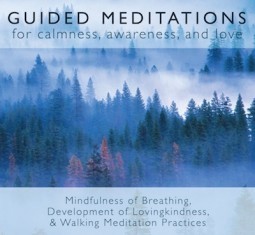Separating feelings and thoughts
 One of the participants in our current 28 Day meditation challenge reported that she was experiencing stress because of a new job.
One of the participants in our current 28 Day meditation challenge reported that she was experiencing stress because of a new job.
New jobs can be very challenging and bring up a lot of self doubt. I remember that well.
She talked about “feelings of inadequacy and uselessness,” and I could instantly see a practice that would help her deal with the challenges of her new job. The practice is to distinguish between feelings and thoughts.
From the perspective of Buddhist psychology, inadequacy and uselessness are not feelings. Actual feelings that we might experience in a challenging new job include anxiety, or fear, or confusion. “I am inadequate” and “I am useless” are thoughts. They are interpretations based on our feelings. “Inadequacy” and “uselessness” are stories that we develop in order to make sense of the feelings of anxiety, confusion, etc. that we’re experiencing. Buddhism calls this prapañca, or “proliferation,”
We’re always trying to come up with stories that “explain” what’s going on in our lives. Stories like “I am inadequate” or “I am useless” serve to intensify our fear and confusion because we’ve “explained” our feelings by creating a story in which there’s something wrong with us that makes us incapable of dealing with the job. But these so-called explanations of why the job’s stressful just make us feel even worse.
 If you like my articles and want to support the work I do, please click here to check out my books, guided meditation CDs, and MP3s. Or you can make a donation.The practice here is to separate our feelings from our stories. So we can feel anxiety or confusion but not create stories around them. Or if stories arise automatically (“I can’t do this, I’m useless”) we can acknowledge them and recognize that they’re just stories, and not facts. We let go of the stories, and just return our attention to our present-moment experience.
If you like my articles and want to support the work I do, please click here to check out my books, guided meditation CDs, and MP3s. Or you can make a donation.The practice here is to separate our feelings from our stories. So we can feel anxiety or confusion but not create stories around them. Or if stories arise automatically (“I can’t do this, I’m useless”) we can acknowledge them and recognize that they’re just stories, and not facts. We let go of the stories, and just return our attention to our present-moment experience.
And having chosen to let go of our stories, we’re free to have other responses to our feelings, like regarding our discomfort with compassion. We can acknowledge our difficult feelings and accept them as a normal part of the learning process; if you’re stretching yourself to take on new capabilities, then of course you’re going to be confused at times, and of course you’re going to feel uncomfortable. We can share with other people how we’re feeling so that we don’t feel ashamed and don’t have to pretend that we understand when in fact we don’t. (Honesty is less stress-inducing than dishonesty, in most cases.)
Separating feelings and thoughts in this way is a key part of Buddhist practice, and it’s a very powerful tool.
Related posts:
“Nothing was ever so unfamiliar and startling to me as my own thoughts.” Henry David Thoreau
Breathe easy to combat anxiety: The mind tricks that can alleviate symptoms
Having a meditation toolkit
Related posts brought to you by Yet Another Related Posts Plugin.




